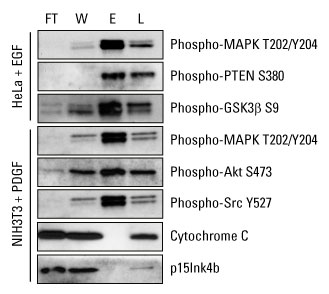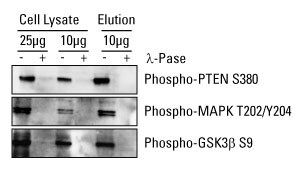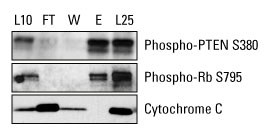Search
Phosphoprotein Enrichment From Cell and Tissue Samples
Isolate phosphorylated proteins with an easy-to-use spin format
by Michael Major, Ph.D.; Wendy Towne, M.S.; Navid Haghdoost, Ph.D.; Barbara Kaboord, Ph.D. - 11/12/12
Reversible protein phosphorylation regulates nearly all intracellular biological events, including signal transduction, protein-protein interactions, protein stability, protein localization, apoptosis and cell-cycle control. Deregulation of protein phosphorylation is a hallmark of numerous human diseases, including cancer and metabolic and immune disorders. However, poorly developed phospho-specific antibodies, the labile state of the phosphate group, and low phosphoprotein abundance make it difficult to study phosphoproteins. In this study, we tested the performance of the Thermo Scientific Pierce Phosphoprotein Enrichment Kit (Part No. 90003) for enriching phosphorylated proteins derived from mammalian cells and tissues.
To evaluate phosphoprotein specificity, we serum-starved HeLa and NIH 3T3 cells and stimulated them with EGF and PDGF, respectively. We processed the cell lysates according to the kit instructions to enrich for phosphoproteins. For western blot analysis, we used phospho-specific antibodies that recognize key regulatory proteins involved in growth-factor signaling. The absence of the non-phosphorylated proteins cytochrome C (pI 9.6) and p15Ink4b (pI 5.5) in the elution fraction and their emergence in the flow-through and wash fractions demonstrated the kit’s specificity (Figure 1).

Dephosphorylation of HeLa cell extract in vitro resulted in reduced binding of PTEN, MAPK and GSK3β to the Phosphoprotein Enrichment Column, as evidenced by their absence in the elution. Conversely, all three proteins were present in the elution fraction from non-treated HeLa extract (Figure 2). The Phosphoprotein Enrichment Kit provided higher phosphoprotein enrichment yields when compared to products from other suppliers (Table 1). The kit also effectively enriched phosphoproteins from homogenized mouse liver tissue (Figure 3).

Table 1. The Thermo Scientific Pierce Phosphoprotein Enrichment Kit provides higher phosphoprotein yields in less time than kits from other suppliers.
| Kit | Phosphoprotein Yield (µg)† | Enrichment Time (Hours) | |||
|---|---|---|---|---|---|
| Pierce Phosphoprotein Enrichment Kit | 300 | 1.5 | |||
| Supplier Q Kit | 88 | 4.5 | |||
| Supplier I Kit | 52†† | 3.5 | |||
| Supplier C Kit | 160 | 3 | |||
| Supplier E Kit | Too dilute to determine | 5 | |||
| †From 2mg total protein; ††Based on maximum 1mg load per manufacturer’s protocol. | |||||

The Pierce Phosphoprotein Enrichment Kit uses a proprietary metal and buffer composition that produces high yields with negligible nonspecific binding. The kit is easy to use and compatible mammalian cells in culture and tissue.
Sample Preparation: Cell culture was performed by growing HeLa (human cervical carcinoma) and NIH 3T3 (mouse fibroblast) cells at 37°C, 5% CO2 in DMEM media containing 10% fetal bovine serum (FBS). Cells were rendered quiescent by serum starvation (0.25%) for 48 hours. Serum-starved HeLa and NIH 3T3 cells were stimulated with 100ng/mL of EGF [Cell Signaling Technology (CST)] for 10 minutes and 50ng/mL of PDGF (CST) for 20 minutes, respectively. After stimulation, cells were washed in non-phosphate buffer (50mM HEPES, pH 7.3). Cell extracts were prepared by adding 1mL of lysis/binding/wash buffer supplemented with Thermo Scientific Halt Protease Inhibitor, EDTA-Free (Part No. 78437) and Thermo Scientific Halt Phosphatase Inhibitor (Part No. 78420) to each 15mL cell culture dish. Cells were scraped into an appropriately sized collection tube and placed on ice for 45 minutes with periodic vortexing. Protein concentrations were determined by Thermo Scientific Pierce Coomassie Plus Bradford Assay (Part No. 23238). For lambda phosphatase treatment, 100μg aliquots of total HeLa cell extract were incubated with 400U of lambda phosphatase (Upstate Biotechnology) at 37°C for 24 hours.
Spin Column Enrichment: Approximately 2mg of total cell extract was diluted to 0.5mg/mL in Lysis/Binding/Wash Buffer. The diluted cell extract was added to a pre-equilibrated Phosphoprotein Enrichment Column and incubated for 30 minutes on a rocking platform at 4°C. Non-bound protein fractions were collected by centrifugation at 1000 x g for 1 minute. The Phosphoprotein Enrichment Column was washed with Lysis/Binding/Wash Buffer (3 x 5mL). Each wash fraction was collected by centrifugation at 1000 x g for 1 minute. Phosphoproteins were eluted with Elution Buffer (5 x 1mL) with a 2-to-3 minute incubation between each centrifugation (1000 x g) step. Elution fractions were pooled and placed in a Thermo Scientific Pierce Concentrator 7 ml/9K MWCO (Part No. 89884) and centrifuged at 2500 x g to achieve 100 to 200μL (approx. 30 minutes). Protein concentrations were determined by Coomassie Plus Bradford Assay. Total purification time was 1.5 hours
Western Blot Analysis: Concentrated protein fractions were resolved by SDS-PAGE using 4-20% gradient gels. Specificity was determined by Western blot analysis using phosphorylated protein-specific antibodies. Antibodies recognizing non-phosphorylated proteins with varying isoelectric points (pI) were used as negative controls. Enrichment was determined by comparing phosphoprotein enrichment elution fractions to total cell extract (non-enriched). Antibodies: phospho-MAPK T202/Y204 (CST), phospho-PTEN S380 (CST), phospho-GSK3β S9 (CST), phospho-Akt S473 (CST), phospho-Src Y527 (CST), phospho-Rb S795 (CST), cytochrome C (Clontech) and p15Ink4b (CST). Primary and secondary antibody dilutions were 1:1000 and 1:5000, respectively, in 5% nonfat dry milk/TBST. Chemiluminescent detection was performed using Thermo Scientific SuperSignal West Pico Substrate (Part No. 34078).
These data were originally published October 2007 in Previews 11(3):2-3.
仅供科研使用,不可用于诊断目的。